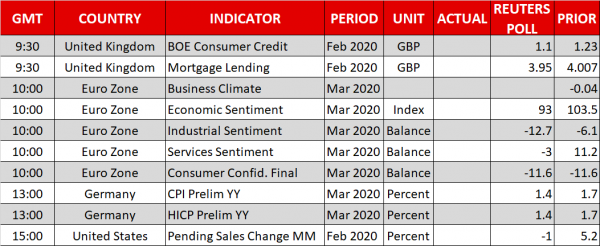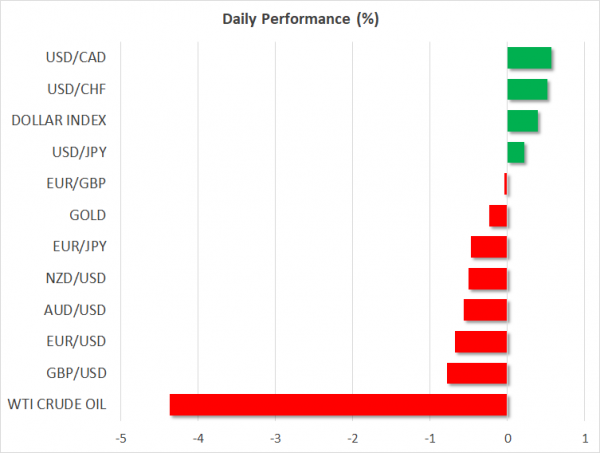- Stocks steady somewhat after Friday’s dip
- Dollar heads higher after worst week since 2009
- Oil skids again; Brent hits 17-year low as world economy shuts down
US stock futures attempt to rebound; risk of increased volatility
Wall Street was unable to extend its winning streak to a fourth day on Friday but still managed to post its strongest week since 2009. Stocks had been steadily rising after a big gap lower at the open but went into reverse after the Federal Reserve said it will rein in its daily purchases of Treasuries to $60 billion from April 2, highlighting how jittery markets still are about possible liquidity shortfalls.
However, it was a somewhat calmer picture today, with US and European stock futures inching higher at one point and helping Asian shares to pare some of their losses. Sentiment remains fragile despite a plethora of stimulus being announced by central banks and governments in recent weeks and today’s bullish efforts could be down to month-end and quarter-end flows as investors adjust their portfolio holdings.
But this also raises the prospect of increased volatility in the next couple of days as the combination of dealers having to execute large volumes of trades from their homes may pose operational constraints. And then there is the liquidity concern as the huge flows may generate a fresh dollar squeeze.
Dollar recovers from 2-week low
The possibility of markets being hit by another round of dollar shortages would undoubtedly bring more pain for emerging market and risk-sensitive currencies and there is already evidence of this at the start of the week’s trading. The Mexican peso and South African rand are down 1.7% and 2.2% respectively, while the aussie and kiwi were last trading down by 0.7% and 0.6% respectively, ending last week’s incredible rally.
The euro and the pound were also struggling, with the euro slipping back below the $1.11 level and the pound dropping below $1.24. The declines could be a technical correction after gaining sharply over the past week as central bank action helped ease the dash for cash, with month-end flows amplifying the moves.
However, Europe remains a major concern for investors as the COVID-19 pandemic shows no sign of slowing. Health services across the region are at breaking point, particularly in Italy, Spain, France and the United Kingdom where the death rate has soared in recent days and key government figures in Britain have tested positive for the coronavirus, including the prime minister.
In contrast, the death rate in the United States remains relatively low despite the country now being officially the epicentre of the disease as the jump in the number of cases there is mainly due to an increase in the number of tests being carried out.
Investors might therefore see the US as being better placed to recover from the crisis, especially after Congress passed a $2.2 trillion stimulus bill and there is now talk of a fourth virus relief package. The US dollar was last up 0.6% versus a basket of currencies, while against the yen, it climbed back above the 108 level.
The safe havens yen and gold were both struggling on Monday even though risk appetite was scarce.
Oil slumps again as lockdowns are here to stay
Oil prices tumbled on Monday, extending last week’s losses as the prospect of a quick end to the crisis continued to diminish. Many countries have imposed strict lockdowns on their citizens in a bid to contain the spread of the virus and tougher measures could yet be imposed in some places if existing policies don’t work.
The lockdowns look set to last at least until the end of April, with President Trump just announcing that the guidelines on social distancing will be extended to April 30. In the UK, officials have warned that it could be six months before life returns to normal, even as many businesses in China reopen for the first time in weeks.
The timescale of the shutdowns is a major source of uncertainty for businesses and for investors, as until there is some clarity on how long these restrictions will stay in place, there’s unlikely to be a convincing turnaround in market sentiment.
This has left commodities such as oil, which have been hurt the most by the collapse in demand, running for cover. Brent crude plummeted by 7.5% to $23.07 a barrel – the lowest in 17 years – while WTI was down 5.2% to $20.40 a barrel.














